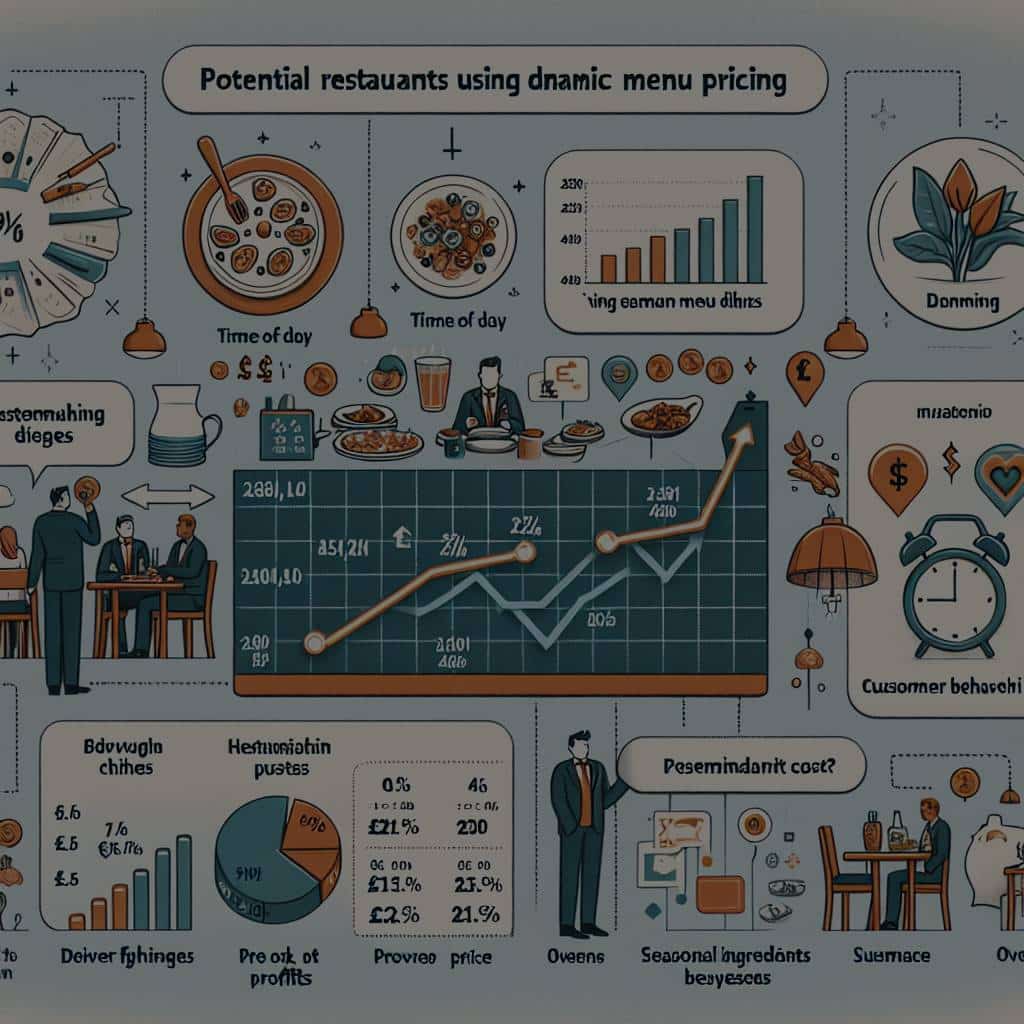How Can UK Restaurants Maximize Profit with Dynamic Menu Pricing?

The art of profitable restaurant management goes beyond creating tantalizing dishes and fostering a cozy ambiance. It extends into areas such as menu pricing, an often overlooked strategy that has the potential to significantly impact your bottom line. This detailed guide will illuminate how you can leverage dynamic menu pricing to maximize profit in your restaurant business.
The Role of Menu Pricing in Restaurant Management
In every restaurant, the menu is more than just a list of food and drink items. It is a strategic document that communicates the brand’s personality, creates a memorable dining experience, and significantly contributes to the business’s bottom line. Dynamic menu pricing, a strategy that involves adjusting menu prices in response to various factors, can be a game-changer for your restaurant.
A voir aussi : How Can UK Independent Bookstores Thrive with Community-Focused Events?
Understanding Dynamic Menu Pricing
Dynamic menu pricing is a pricing approach that adjusts the price of menu items based on several factors, such as supply and demand, customer preferences, seasonality, and market trends. This strategy embraces flexibility, ensuring that your restaurant stays competitive and profitable.
The Power of Data in Dynamic Pricing
The successful implementation of dynamic menu pricing greatly relies on data. You need to constantly assess and understand your customers’ behaviours and preferences, keep a close eye on market trends, and stay informed about the costs of your raw materials. Data analysis can provide invaluable insights that will guide your pricing decisions.
A voir aussi : What Are the Strategies for Improving Indoor Air Quality in UK Office Spaces?
How to Implement Dynamic Menu Pricing
Implementing dynamic menu pricing requires a deep understanding of your restaurant’s operations and consumer behaviour. It involves a careful analysis of several factors to determine optimal pricing for each item on your menu.
Assessing Costs and Profit Margins
Before you can effectively adjust your menu prices, you need to fully grasp the cost structure of your restaurant. This means understanding the cost of every ingredient that goes into each dish, as well as overhead costs like rent, utilities, and staff salaries.
Once you’ve calculated the cost of each dish, you can then determine the price that will yield a healthy profit margin. Keep in mind, however, that your prices should also reflect the perceived value of the food and the dining experience you offer.
Understanding Customer Demand and Preferences
Successful dynamic pricing also hinges on understanding customer demand and preferences. Regularly gather and analyze data on your top-selling items, customer feedback, and dining trends in your area.
With this information, you can adjust pricing for popular items, introduce new dishes that meet emerging customer demands, and eliminate or rework low-performing items. Remember, an item’s popularity can significantly influence its price.
Leveraging Technology in Dynamic Pricing
With the rapid advancement of technology, several tools can help you implement dynamic pricing effectively. These solutions can help streamline the process, taking care of data collection and analysis, and even making pricing suggestions based on real-time data.
Restaurant Management Software
A robust restaurant management software can be a game-changer for your dynamic pricing strategy. This software can track and analyze sales data, customer preferences, and inventory costs, providing you with a comprehensive view of your restaurant’s performance.
Some advanced restaurant management software also comes with predictive analytics capabilities. These can forecast future sales trends, allowing you to adjust your menu pricing proactively.
Customer Feedback Tools
Incorporating customer feedback is crucial in dynamic pricing. Tools like online surveys, comment cards, or social media analytics can help you gather this feedback efficiently.
Understanding your customers’ perceptions of your menu and pricing can provide valuable insights. These insights can guide you in making pricing decisions that will boost both customer satisfaction and your profits.
Dynamic Pricing and Customer Perception
A key challenge in implementing dynamic menu pricing is managing customer perception. While dynamic pricing can maximize profits, it’s crucial to implement it in a way that maintains customer trust.
Transparent Communication
Transparency in your pricing strategy is crucial. If customers understand that prices are subject to change based on various factors, they are more likely to accept these changes. Moreover, if the changes are linked to improving the quality of food or service, customers may even perceive them positively.
Consistent Value
Finally, regardless of your pricing strategy, always strive to provide consistent value. Whether you run a fine dining restaurant or a fast food joint, always ensure your customers feel that they are getting their money’s worth. Providing excellent food and service will keep customers coming back, time and time again.
In conclusion, dynamic menu pricing is a powerful strategy for maximizing profits in your restaurant business. However, it requires careful planning, a deep understanding of your costs and customer preferences, and the right technology tools. And, as you navigate this process, never lose sight of the importance of maintaining customer trust and providing consistent value.
A Case Study: Dynamic Pricing in Action
A practical illustration of dynamic pricing comes from the airline and hospitality industry. Airlines and hotels have long used dynamic pricing strategies, adjusting their rates based on factors like demand, time of booking, and inventory. This approach, also known as yield management, has proven highly effective in these industries, and its principles can be applied to the restaurant business as well.
For instance, a restaurant might implement dynamic pricing by adjusting menu prices based on time of day or week. The prices of certain menu items could be increased during busy periods, such as weekend evenings, and reduced during quieter periods to attract more customers. Similarly, the prices could be adjusted based on seasonality, with certain dishes becoming more expensive when their ingredients are out of season and thus more costly to procure.
A real-world example of a restaurant successfully employing this strategy is Bob Bob Ricard, a high-end restaurant in London. They introduced an off-peak pricing system where they offer lower prices at less busy times. This has led to an increased profit margin and a boost in off-peak bookings.
However, implementing this strategy isn’t without challenges. A key concern is managing customer perceptions and preventing potential backlash. Transparency and clear communication are vital to ensure customers understand why prices may vary.
Enhancing the Guest Experience with Dynamic Pricing
In addition to maximizing profits, dynamic pricing can also enhance the guest experience in your restaurant. By adjusting your prices according to demand, you can manage guest flow more effectively, ensuring a comfortable dining experience for all customers.
During peak hours, when your restaurant is likely to be full, higher prices can help control the number of customers and prevent overcrowding. Meanwhile, lower prices during off-peak hours can attract customers who prefer a quieter, more relaxed dining environment.
Implementing dynamic pricing can also give you the flexibility to offer special promotions and discounts. For instance, you could offer discounted prices for seniors during off-peak hours or special promotions for students during weekdays. These strategies not only attract more customers but also create a positive guest experience, which can enhance your brand’s reputation and lead to repeat business.
Remember, the ultimate aim of dynamic pricing is not just to increase profit margins but also to create a better dining experience for your customers.
Conclusion: Maximizing Restaurant Profit with Dynamic Pricing
In the fast-paced and competitive world of the restaurant industry, dynamic menu pricing can be a game-changer. This innovative pricing strategy allows you to maximize your profit margins without sacrificing the quality of your food or guest experience.
However, implementing dynamic pricing requires a deep understanding of your costs, customer demands, and market trends. It also requires leveraging technology, from restaurant management software to social media analytics, to gather and analyze the necessary data. And most importantly, it requires careful management of customer perceptions through transparent communication and consistent value.
In the end, the success of dynamic pricing lies in its ability to balance the business’s needs with customer satisfaction. By doing so, you can ensure the long-term profitability and success of your restaurant business.
